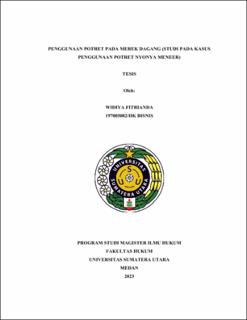| dc.description.abstract | The use of portraits in trademarks has sparked controversy because copyright
and trademarks are part of the intellectual property rights (IPR) regime, each with
different concepts of protection and objectives. This raises questions about whether
the portraits used in trademarks still retain exclusive right as creations protected by
the copyright law of 2014 or whether their protection falls under the scope of
trademarks.
The objectives of this research are threefold: first, to determine, examine, and
analyze the legal regulations regarding the transfer of rights to the trademark “Jamu
Cap Potret Nyonya Meneer” (Mrs. Meneer’s Portrait Jamu). Second, to determine,
examine, and analyze the legal protection for the use of Mrs. Meneer’s Portrait in the
trademark “Jamu Cap Potret Nyonya Meneer”. Third, to determine, examine, and
analyze the considerations of the judges in the decision No. 2/Pdt.Sus-
HKI/Cipta/2020?PN Niaga Smg concerning the portrait used in the trademark.
The method used in this research in normative legal research with the
approach employed includes the statutory approach and case approach. The analysis
method utilized is qualitative analysis.
The research findings indicate that the rights to trademarks can be
transferred and assigned permanently based on the provisions of Article 41
paragraph (1) letter f of Law No. 20 of 2016. The regulations concerning the use of
portraits in trademarks are not clearly stipulated in the Copyright Law of 2014 and
Law No. 20 of 2016. However, implicitly, it can be inferred from Article 9 paragraph
(1), Article 12 of the Copyright Law of 2014, and Article 21 paragraph (2) letter a of
Law No. 20 of 2016. Legal protection for Mrs. Meneer’s Portrait includes both moral
rights and economic rights. The economic rights protections for Mrs. Meneer’s
Portrait has expired, while the moral rights protection still applies due to its inherent
and perpetual nature to its creator. The legal protections for Mrs. Meneer’s Portrait
is granted to the photographer. The Panel of judges ruled that the Plaintiff’s lawsuit
was an error in persona, but it actually referred to the photographer who is the
creator of copyright holder of the portrait, which was not mentioned in this case.
It is recommended that lawmakers create clear regulations regarding the use
of portraits in trademarks. Additionally, it is advised fot the official from the
Directorate General of Intellectual Property Rights who are authorized to continue to socialize and educate the public and law enforcement officials about copyright and
trademarks. | en_US |


